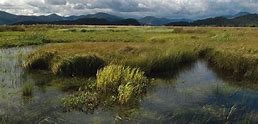
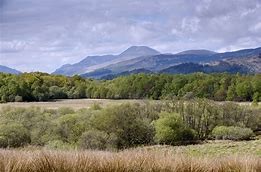
I have liaised with Nick Kempe on matters relating to the Loch Lomond and Trossachs National Park for several years now but, in his recent blog (see here) on the recent planning approval for the RSPB path in the Loch Lomond and Trossachs National Nature Reserve, I think he has underplayed the importance of nature. Here I explain why.
The four statutory aims of the National Park are a material planning consideration. These are set out in Section 1 of the National Parks (Scotland) Act 2000 and are:
a) to conserve and enhance the natural and cultural heritage of the area;
b) to promote sustainable use of the natural resources of the area;
c) to promote understanding and enjoyment (including enjoyment in the form of recreation) of the special qualities of the area by the public; and
d) to promote sustainable economic and social development of the area’s communities.
Section 9 of the Act states that these aims should be achieved collectively. However, if in relation to any matter it appears to the National Park Authority that there is a conflict between the first aim, and the other National Park aims, greater weight must be given to the conservation and enhancement of the natural and cultural heritage of the area.
RSPB’s purchase and management of the Wards Estate

The Royal Society for the Protection of Birds purchased part of the Ward’s Estate with the help of £172k grant from the National Heritage Memorial Fund in 2011 (see here)
“RSPB Scotland acquired part of the Wards Estate, an area of land on the south east bank of Loch Lomond, which is of European importance for nature conservation.
The conservation charity has unveiled plans for a 563 acre nature reserve that it will manage in a pioneering partnership with Scottish Natural Heritage (SNH) and Loch Lomond & The Trossachs National Park Authority(LLTNPA). This major purchase, of which RSPB Scotland will contribute two thirds of the total cost, will be made possible thanks to the partnering organisations plus a generous grant from the National Heritage Memorial Fund (NHMF). An appeal for donations from RSPB members and the public has also been launched. It comes exactly 50 years after this part of Loch Lomond was first declared a National Nature Reserve.
The managing partnership will ensure that the site will be managed as a hot spot for wildlife on Loch Lomond supporting breeding and wintering waders and waterfowl, and nationally rare plants such as the endemic Scottish or Loch Lomond dock. Ospreys are regular summer residents and can be enjoyed by all who visit this very special part of the national park.
It’s the first time that a non-government wildlife organisation, a national park and a statutory conservation body have joined forces in this way to acquire and look after a key site for biodiversity in Scotland.”
There have been 8 planning applications (according to the LLTNPA paper) submitted to Loch Lomond & Trossachs National Park Authority since its purchase, including new paths. All were APPROVED.
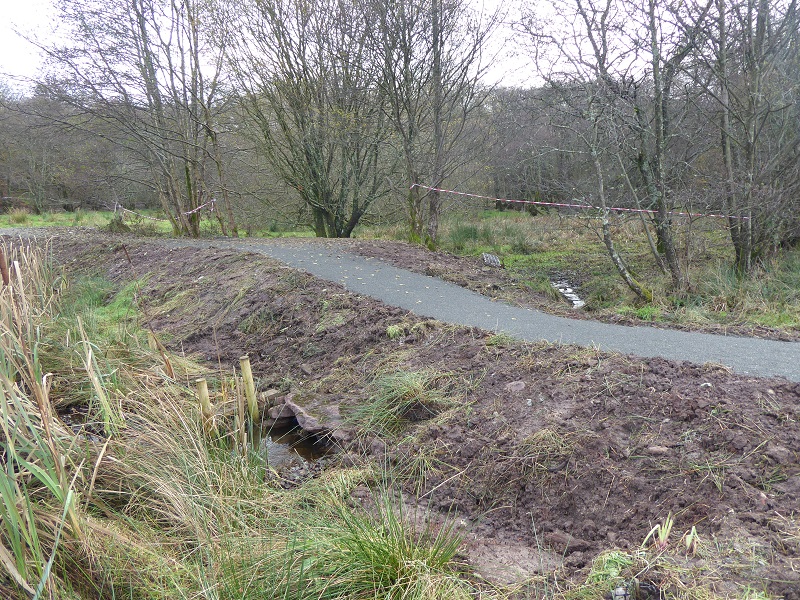
The latest application for “Construction of footpath/boardwalk with planting, seating, interpretation focal points (including a shelter), pedestrian gates and associated works” was decided at a Virtual Planning and Access Committee Meeting on 25th May ’20 (see here).
Issues raised by the Community Council
This application was considered by the Kilmaronock Community Council (KCC), which covers the area, at an ordinary meeting on 2nd September (see here for minute) where it was reported:
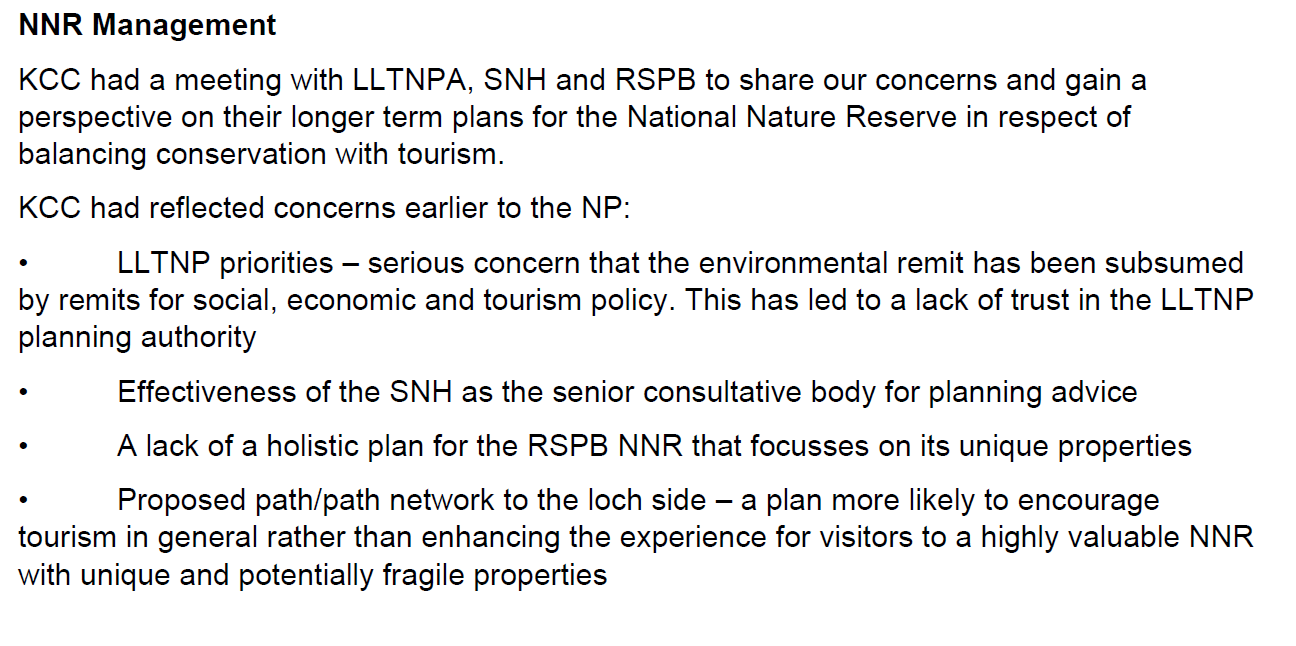
 What is the hidden agenda? SNH makes the plans for its NNRs public so why not the RSPB? The minute goes on to record:
What is the hidden agenda? SNH makes the plans for its NNRs public so why not the RSPB? The minute goes on to record:
“We were advised the visions around visitor numbers in terms of facilities to be provided – the Plan indicates 8,000 per year.”
Apparently, a figure of 40,000 visitors had been had been mooted previously to KCC by LLTNPA Chief Executive Gordon Watson! Despite these concerns, the KCC ended up being reassured about the application and did not submit an objection.
The Planning Application
The Committee Report noted (3.2):
“The reserve comprises 237ha of fen, woodland and grassland habitats which are owned and managed by the RSPB. The reserve contains designations of national and international importance. The part of the reserve that would be crossed by the proposed footpath is subject to the following designations (Figure 2): · Loch Lomond Special Protection Area (SPA), · Endrick Mouth and Islands Site of Special Scientific Interest (SSSI); · RAMSAR (wetlands of international importance); and · Loch Lomond National Nature Reserve (NNR).”
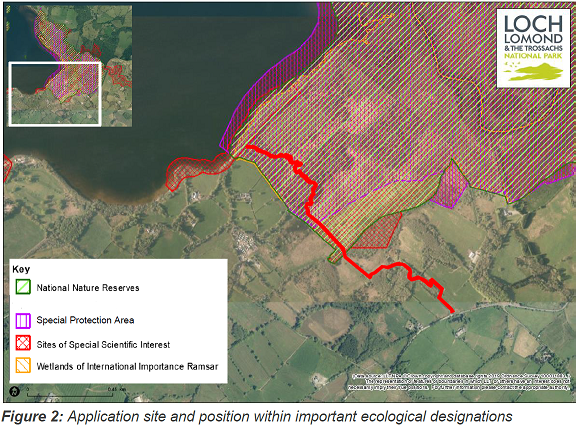
The Loch Lomond NNR at Wards Farm was intended to be one of the most protected areas in Scotland! However:
“The vision for RSPB’s Loch Lomond Reserve, as stated in the RSPB Management Plan (April 2019-March 2024), is for the reserve “to be a flagship site for both nature conservation and visitor experience in the National Park”” (para 3.4)
with
“….ambitions for a permanent visitor centre with facilities, office and possible car park expansion in the longer term”. (3.7).
The development was described as follows:
“The proposed footpath would be 2m wide and would vary in design along its length depending on the ground conditions and habitat sensitivity (Figure 5). Boardwalk is proposed through the wetland/fen area. This would be constructed from recycled plastic supports with proprietary resin mineral board treads (golden oak colour) and would be a maximum of 2m wide and 60mm high. Short sections of narrower boardwalk are proposed for other parts of the route in areas of soft ground or those prone to seasonal flooding. These sections would be 1.2m wide and a maximum of 300mm high”.
The Committee Report recommended that Members “APPROVE the application subject to the imposition of the conditions” (set out in Appendix 1 of the report).
In the Virtual meeting, which I watched, Committee Members did ask some questions of the presenters e.g:
Question: Was the path close to feeding areas (of the protected White Fronted Geese)?
Answer: No exact distance but likely to be 10 metres. “Although the route of the path in this area was specifically chosen to take advantage of existing screening and back-clothing by trees and other vegetation, several locations were identified where existing vegetation was not sufficient to screen the path from any geese using the field. The lack of existing screening in these areas could result in disturbance to the GWF [Greenland White Front] during the construction and use of the path in the winter months.”
Question: What would be the impact of work in the construction corridor?
Answer: The biggest impact would be during winter months when White Fronted Geese are present but works are not to commence if geese are present … will be monitored each day prior to work commencing.
Question: Do Scottish Natural Heritage not have any objections?
Answer: the NNR is for people to enjoy and, on the potential impact the LLTTNPA consulted SNH which has no objections.
Question: If things went wrong with the proposed work could it be undone/restored ?
Answer: No answer!
Questions about monitoring were raised several times
Answers: SNH had duty to monitor protected habitats; LLTNPA has recently recruited monitoring personnel; NPA Partnership Plan has monitoring inbuilt; RSPB happy to share their monitoring. “A programme of ongoing monitoring (and mitigation as required) shall be undertaken in accord with the details set out in the submitted Ecological Assessment (received 19 December 2019). The results of the monitoring and mitigation shall be made available to the Planning Authority on request.” (Condition 14).
An amendment to 14 was asked for so that instead of “A programme … shall be made available to the Planning Authority on request” monitoring reports would be REQUIRED to be made available …
It was disappointing that only two of the four Board members who are local to the area concerned were ‘present’: Ellen Morton Chair of the Planning Committee sent apologies and David McCowan could apparently be seen but not heard. However, it was cheering that Willie Nisbet, who lives near Gartocharn and has local knowledge, proposed that a site visit. This was seconded by Diane Docherty West Dunbartonshire Councillor (RSPB being in West Dunbartonshire).
David McKee, lawyer to LLTNPA, said that the Park and SNH were satisfied. QED there was no requirement for a site visit. The proposed motion to defer a decision pending a site visit went to a vote. All but the two Committee members proposing the motion voted that a site visit was not necessary.
Members then went on to APPROVE the Planning Application.
Conflicts of interest and what is in the interests of nature conservation
As a partner in the management of the NNR, there is a clear conflict of interest in the LLTTNPA deciding this application. It was the LLTTNPA who conducted the screening opinion about whether an Environment Impact Assessment was required (the outcome of this was report on 14th January 2019 – PSC/2018/0004)
In relation to the development proposed it is considered that there is low probability of any significant impact having regard to the criteria set out in Schedule 3 of the regulations and, in particular, having regard to the scale and characteristics of the proposed land use in the location proposed.
They couldn’t avoid, however, making something called an Appropriate Assessment under the Habitats Regulations but this ONLY considered the impact on the Greenland Whitefronted Goose. It concluded the path would “not have an adverse effect on the integrity of the Loch Lomond SPA [Special Protection Area]”. This was on the basis that the most important areas for the geese feeding and roosting were on other parts of the site. That ignores other wildlife and sets a dangerous precedent, separating out parts of protected sites which are expendable from those that are not. For the geese, it leaves no space for them to expand into new areas in future. There was no requirement in the Application that the RSPB extend the NNR elsewhere to compensate for the loss.
This Application raises some important questions:
- Can the LLTTNPA be trusted to make and impartial decision? and
- Should the LLTTNPA have been the Planning Authority making this decision at all?
The role of the board members who make up the planning committee is to scrutinise and determine the outcome of applications before it. In that regard, the regulations, guidance and standards incumbent on committee members clearly separate out their role from that of the officers who may perform many aspects of the assessment which is presented to members. The question of whether or not those members do a good job of scrutiny is a separate issue. There is no ‘conflict of interest’ per se. Otherwise, no local authority could ever determine an application to build a new school, for instance. What IS highly arguable, if the statement is accurate, is the assertion that the LLTPNA lawyer actually said the ‘the park and snh were satisfied. QED there was no requirement for a site visit’. This was not just unwarranted intervention, but also blatant ‘leading’ of the committee. The layer’s role is to support the committee by ensuring that they receive appropriate guidance when necessary to ensure the committee members act properly within their defined statutory functions. Ir is NOT to support the officer conclusions (which were self-evident), or to support a third party’s view.The committee can legitimately request a site visit for any application if they feel that seeing the site ‘on the ground’ will assist them in scrutinising the application properly. It is hard not to conclude that the lawyers intervention as stated will have had a substantial effect on some members who might have been minded to vote for the motion.
There are vast areas of the National Park which are effectively inaccessible and thus undisturbed. The tiny part which comprises the area around the south of the loch and the islands has been used for recreation for more than a hundred years and the wildlife in that area has coexisted quite happily. Yet it is in that area that LLTPA has been using the “priority” clause mentioned above to continually increase restrictions on human activity.
The provision of formal paths and car parks etc. is a double edged sword in this respect; while superficially it looks like an increase in facilities for recreation, it is used as a means to concentrate activity in designated places so that it can be managed and controlled. It should be glaringly obvious right now how this can be abused.
In the same way boat launching has in recent years been concentrated on the LLTPA slip at Balloch by various means, now it is closed for one weekend every year in peak season for a swimming event which could be held elsewhere. The principle being established in both cases is that you use the Park only at the discretion of LLTPA.